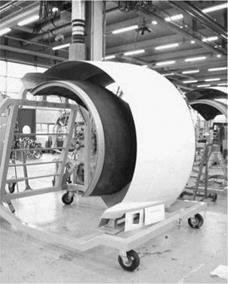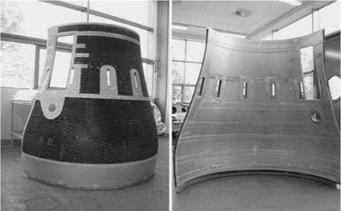Aircraft manufacture is the number one field of application for high-performance bonding technology. However, with few exceptions, there has been a certain regression — or at least stagnation — in the application and further development of structural bonding. Problems which occurred during the 1970s contributed especially towards this trend. In metal aircraft manufacture, approximately 10-15% of the structural weight may be saved when the predominant riveting technology is consistently replaced by adhesive bonding; that is, upto4t may be saved in the case of a more important commercial aircraft. However, for weight reduction, interest has focused mainly on fiber-reinforced plastics, including systems reinforced with carbon fibers, that make it possible to save weight in approximately the same order of magnitude as adhesive bonding technology when used consistently and comprehensively. This method has certainly contributed to the optimization of aircraft performance, including greater safety for the passengers in the case of a fire — a fact which, in many cases, is not considered. However, the use of carbon-fiber- reinforced plastics has also resulted in an unexpected ‘cost explosion’ compared to the traditional structural metal design, with components such as spoilers or flaps made from fiber composites costing twice as much as their metal counterparts. Moreover, there is also some uncertainty about the standardization of repair processes worldwide. Hence, in the case of an isolated damage the components are replaced rather than repaired, further increasing the cost factor because these replacements are very expensive.
It should be pointed out, however, that the materials are not the only cost factor. In the majority of cases integral construction designs (i. e. monolithic structures) with very complex geometry are used, the manufacture of which is very expensive. The bonding technology that makes it possible to replace very large, complex structures with several simple components could lead to a considerable reduction in these costs.
In fact, in some cases cost reduction has been achieved by returning to former metal construction designs, although this automatically involves adhesive bonding technology, possibly using magnesium and aluminum-lithium alloys. Although the
latter approach may still be problematic to some extent, such components have been used recently, and the results of several series of experiments have indicated that, at least with regards to long-term bonding aspects, very few problems are expected with these materials.
Clearly, these aspects of weight reduction and cost savings will shape further developments in aircraft manufacture [1]. Indeed, today the situation is changing in dramatic manner and the saving of weight is now of great importance. Recently, ecological concerns have become more important than raw material aspects, so that fuel consumption will continue to be an important issue.
In all transportation systems, the most efficient way to save costs is to save weight. Although bonding does save weight, it is still quite expensive compared to riveting, which is basically an automated technology. Nevertheless, cost savings will most likely be achieved in the near future with the use of simplified surface preparation techniques and the automated application of paste-like, possibly cold-setting, adhesives. At present, two groups of adhesives are used:
• Flyaway products include impact-protection foils or paint replacement foils that are applied onto and remain within jet aircraft, and are subject to the most rigorous quality requirements (e. g. fire protection, mechanical loading). Examples include rotor blades or structures such as carbon-fiber Airbus tail-units, which are bonded with epoxy adhesives. The stringers and dampers of aircraft floors are also bonded, as are sandwich-structure engine fairings (Figures 8.2 and 8.3), aeration systems, fastening devices, insulations or decorative elements. An interesting structural
|
Figure 8.2 Bonded sandwich structure with aluminum cover sheets and aluminum honeycomb core in a fan reverser of a civil aircraft. (Photo courtesy of Lufthansa). |
|
Figure 8.3 A bonded aluminum sandwich. The outer cover sheet (here separated) is perforated for noise absorption. (Photo courtesy of Lufthansa). |
application here is the bonding of different metals, as adhesives may compensate for material tensions due to different coefficients of linear expansion, while their good insulation properties may prevent corrosion by electrochemical reactions.
• Maintenance products include masking tapes that are removed after use, and remain on the ground as they are not a permanent, integral part of the aircraft. The material requirements are less severe in such cases.
 5 ноября, 2015
5 ноября, 2015  Pokraskin
Pokraskin 

 Опубликовано в рубрике
Опубликовано в рубрике 